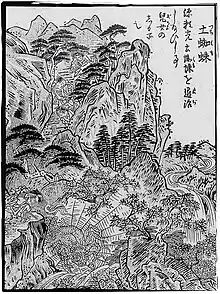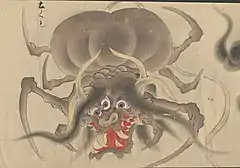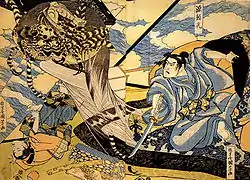Tsuchigumo
Tsuchigumo (土蜘蛛, literally translated "dirt/earth spider") is a historical Japanese derogatory term for renegade local clans, and also the name for a race of spider-like yōkai in Japanese folklore. Alternate names for the mythological Tsuchigumo include yatsukahagi (八握脛) and ōgumo (大蜘蛛, "giant spider").[1] In the Kojiki and in Nihon Shoki, the name was phonetically spelled with the four kanji 都知久母 (for the four morae tsu-chi-gu-mo),[2] and these words were frequently used in the fudoki of Mutsu, Echigo, Hitachi, Settsu, Bungo and Hizen as well as others.


The Japanese name for large ground-dwelling tarantulas, ōtsuchigumo, is due to their perceived resemblance to the creature of the myth, rather than the myth being named for the spider. Japan has no native species of tarantula, and the similarities between the mythical and the actual creature—huge wandering spiders with an obvious face that like to hide in burrows—were entirely coincidental. The fact that the later iterations of the myth specifically refer to the body being that of a tiger, however, does imply that the description was influenced to some degree by the Chinese bird spider, which is commonly referred to as the "earth tiger" in its native habitat for its furry, prominently striped body and aggressive disposition.
In history
According to the 18th-century historian Motoori Norinaga, in ancient Japan, Tsuchigumo was used as a derogatory term against aborigines who did not show allegiance to the emperor of Japan.
There is some debate on whether the mythical spider-creature or the historical clans came first. One theory is based on the knowledge that beginning with the earliest historical records, those who waged war against the imperial court were referred to as oni by the imperial court, both in scorn and as a way to demonize enemies of the court by literally referring to them as demons. Tsuchigumo may have been a pre-existing but obscure myth picked as the term of choice for a more humble threat to the empire, after which it was popularized. Alternately, the word tsuchigumo has been identified a derivation of an older derogatory term, tsuchigomori (土隠),[3] which roughly translates as "those who hide in the ground". This term refers to a common practice among many of the rural clans: utilizing existing cave systems and creating fortified hollow earthen mounds for both residential and military purposes.This implies that the use of the name for renegade clans began essentially as a pun, and over time tales surrounding a literal race of intelligent, occasionally anthropomorphic, spiders grew from this historical usage, first as allegory, then as myth.
In the following examples from ancient historical records and accounts, tsuchigumo is used variously to describe well-known individual bandits, rebels, or unruly clan leaders, and also applied to clans as a whole. In some cases it is unclear in which way the term is being used. Its usage as a figurative term denotes that the person or clan referred to was defying Imperial authority in some covert but consistent fashion, generally by guerrilla warfare or actively eluding discovery.
Tsuchigumo of the Katsuragi
Of the clans referred to as tsuchigumo, those of the Mount Yamato Katsuragi are particularly well known. Katsuragi Hitokotonushi Shrine (葛城一言主神社, Katsuragi Hitokotonushi Jinja) was said to be the remains where Emperor Jimmu captured tsuchigumo and buried their head, body and feet separately to prevent their grudges from harming the living.[4]
In historic Yamato Province, the unique physical characteristics of the tsuchigumo were that they were tailed people. In the Nihon Shoki, the founder of the Yoshino no Futo (吉野首) were written to be "with a glowing tail," the founder of Yoshino no Kuzu (国樔) were stated to "have tails and come along pushing rocks (磐石, iwa)," presenting the indigenous people of Yamato as non-humans. Even in the Kojiki, they shared a common trait with the people of Osaka (忍坂) (now Sakurai city) in that they were "tsuchigumo (土雲) who have grown tails."
Records from the Keiko generation and others
In the Hizen no Kuni Fudoki, there is an article writing that when Emperor Keiko made an imperial visit to Shiki island (志式島, Hirado island) (year 72 in the legends), the expedition encountered a pair of islands in the middle of sea. Seeing smoke rising from inland, the Emperor ordered an investigation of the islands, and discovered that the tsuchigumo Oomimi (大耳) lived on the smaller island, and Taremimi (垂耳) lived on the larger island. When both were captured and about to be killed, Oomimi and Taremimi lowered their foreheads to the ground and fell prostrate, and pleaded, "we will from now on make offerings to the emperor" and presented fish products and begged for pardon.
Also, in the Bungo no Kuni Fudoki, there appeared many tsuchigumo, such as the Itsuma-hime (五馬姫) of Itsuma mountain (五馬山), the Uchisaru (打猴), Unasaru (頸猴), Yata (八田), Kunimaro (國摩侶), and Amashino (網磯野), of Negi field (禰宜野), the Shinokaomi (小竹鹿臣) of Shinokaosa (小竹鹿奥), and the Ao (青) and Shiro (白) of Nezumi cavern (鼠の磐窟). Other than these, there is also the story of Tsuchigumo Yasome (土蜘蛛八十女), who made preparations in the mountains to resist against the imperial court, but was utterly defeated. This word "Yaso" (八十), literally "eighty," is a figurative term for "many," so this story is interpreted to mean that many of the female chief class opposed the Yamato imperial court, and met a heroic end, choosing to die alongside their men. In the story, Yaso, one local female chief, was greatly popular among the people, and she separated her allies from those resisting the imperial forces. Tsuchigumo Yasome's whereabouts were reported to the emperor, and for her efforts she was spared.[5]
According to writings in the Nihon Shoki, in the 12th year of emperor Keiko (year 82 in the legends), in winter, October, emperor Keiko arrived in Hayami town, Ookita (now Ooita), and heard from the queen of the land, Hayatsuhime (速津媛) that there was a big cave in the mountain, called the Nezumi cave, where two tsuchigumo, Shiro and Ao, lived. In Negino (禰疑野), Naoiri, they were informed of three more tsuchigumo named Uchizaru (打猿), Yata (八田), and Kunimaro (国摩侶, 国麻呂). These five had great amount of allies, and would not follow the emperor's commands.[6]
Yōkai tsuchigumo

From the Japanese middle ages (Kamakura/Muromachi/Azuchi-Momoyama periods, or the late 12th to the early 17th centuries) onward, tsuchigumo began to be depicted as giant, monstrous spiders.
A commonly cited early text depicting the yōkai tsuchigumo is The Tale of the Heike, or rather some variant texts of the Heike. This work, which was passed down orally among biwa lute players, has a complicated textual history and numerous variants, including the massively expanded Genpei Jōsuiki, and some versions include an extended passage on swords, known as the "Sword Scroll", or tsurugi-no-maki. This is regarded as one of the most important and influential texts that depict the conflict between Yorimitsu and the tsuchigumo, and is the source for many later artistic representations.[7] It describes Yorimitsu's using the sword Hizamaru to defeat a yamagumo, which led to his renaming it "Kumogiri" (蜘蛛切, "Spider-Cutter").[8]
Works such as the 14th-century picture scroll Tsuchigumo Sōshi and the 15th-century Noh drama Tsuchigumo envision various versions of a legend in which Minamoto no Yorimitsu, also known as Raikō, a famous 10th-century general and ancestor of the Minamoto clan defeat an enormous spider yōkai referred to as a tsuchigumo or yamagumo ("earth spider" or "mountain spider", respectively). In some versions, Yorimitsu and his retainer Watanabe no Tsuna pursue the spider, which takes various forms such as a beautiful woman, and when they defeat it they cut it open and skulls pour out of its torso, while in others, Yorimitsu is incapacitated and a young retainer hunts the spider down in his stead.
Tsuchigumo Sōshi (see scrolling image below) interestingly contains a visual depiction that doesn't appear to match the accompanying text, as the text has Yorimitsu and Tsuna take down an enormous, 60-foot monster that they later realize is a giant spider, but the imagery shows them doing battle with two oni, or ogre-demons, resembling Gozu and Mezu, which perhaps represent another of the tsuchigumo's transformations.
References
Citations
- 岩井宏實 (2000). 暮しの中の妖怪たち. 河出文庫. 河出書房新社. pp. 156頁. ISBN 978-4-309-47396-3.
- 京極夏彦・多田克己 編著 (2008). 妖怪画本 狂歌百物語. 国書刊行会. pp. 293–294頁. ISBN 978-4-3360-5055-7.
- 奈良国立文化財研究所 佐原眞 『体系 日本の歴史 1 日本人の誕生』 小学館、1987年、178頁。ISBN 4-09-622001-9。
- 村上健司 編著 (2000). 妖怪事典. 毎日新聞社. pp. 222頁. ISBN 978-4-620-31428-0.
- 義江明子『古代女性史への招待――“妹の力”を超えて』
- 日本書紀 の参考部分:日本書紀 巻第七日本書紀(朝日新聞社本)《景行天皇十二年(壬午八二)十月》冬十月。到碩田国。・・・因名碩田也。・・・到速見邑。有女人。曰速津媛。・・・茲山有大石窟。曰鼠石窟。有二土蜘蛛。住其石窟。一曰青。二曰白。又於直入県禰疑野、有三土蜘蛛。一曰打猿。二曰八田。三曰国摩侶。是五人並其為人強力。亦衆類多之。皆曰。不従皇命。
- Reider 2013, p. 56.
- Shida 1983, p. 389.
Works cited
- Reider, Noriko T. (2013). "Tsuchigumo sōshi: The Emergence of a Shape-Shifting Killer Female Spider". Asian Ethnology. Nanzan Institute for Religion and Culture. 72 (1): 55–83. Archived from the original on 2017-01-25. Retrieved 2020-10-19.
- Shida, Itaru (1983). "Heike Tsuruginomaki". Nihon Koten Bungaku Daijiten 日本古典文学大辞典 (in Japanese). 5. Tokyo: Iwanami Shoten. p. 389. OCLC 11917421.
Further reading
- Asiatic Society of Japan. Transactions of the Asiatic Society of Japan: Volume 7. The Society. (1879)
- Aston, William George. Shinto: the way of the gods. Longmans, Green, and Co. (1905)
- Brinkley, Frank and Dairoku Kikuchi. A history of the Japanese people from the earliest times to the end of the Meiji era. The Encyclopædia Britannica Co. (1915)
- Horne, Charles Francis. The Sacred books and early literature of the East. Parke, Austin, and Lipscomb: (1917)
- Oyler, Elizabeth. "The Nue and Other Monsters in Heike Monogatari." Harvard Journal of Asiatic Studies 68, no. 2 (2008): pp. 1-32. Accessed May 24, 2020. www.jstor.org/stable/40213671.
- Reider, Noriko T. "Tsuchigumo Sōshi: The Emergence of a Shape-Shifting Killer Female Spider." Asian Ethnology 72, no. 1 (2013): pp. 55-83. Accessed May 24, 2020. www.jstor.org/stable/41958916.
- Reider, Noriko T. "A Tale of an Earth Spider (Tsuchigumo Zōshi): The Emergence of a Shape-Shifting Killer Female Spider." In Seven Demon Stories from Medieval Japan, 62-86. Boulder, Colorado: University Press of Colorado, 2016. www.jstor.org/stable/j.ctt1g04zg4.6.
- Reider, Noriko T. Japanese Demon Lore: Oni, From Ancient Times to the Present. Logan, Utah: Utah State University Press, 2010. pp. 165-169 (two examples of Tsuchigumo in modern media).
- RODRÍGUEZ, AMAURY A. GARCÍA. "ITINERARIOS DE UNA APROPIACIÓN CRÍTICA: RAIKŌ Y LA ARAÑA DE TIERRA." Estudios De Asia Y Africa 45, no. 3 (143) (2010): 535-65. Accessed May 24, 2020. www.jstor.org/stable/25822400.
- Studio international, Volume 18. Studio Trust. (1900)
- Takeuchi, Melinda. "Kuniyoshi's "Minamoto Raikō" and "the Earth Spider": Demons and Protest in Late Tokugawa Japan." Ars Orientalis 17 (1987): 5-38. Accessed May 24, 2020. www.jstor.org/stable/4629355.
- Trench, K. Paul. Nihongi: chronicles of Japan from the earliest times to A.D. 697: Volume 1. The Society. Trübner. (1896)


